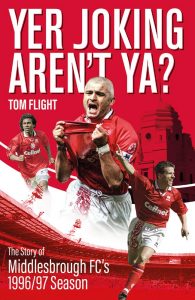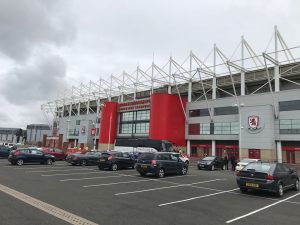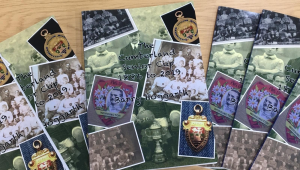 Football is a game that is not just about the elite at the top of the professional pyramid. Up and down the country on weekends during the season, park pitches ring to the sound of players of all shapes, sizes and abilities giving it their all at the grassroots level. Peter Roberts has recorded that story from his perspective in his book, Park Life: Four seasons of Rhondda football, and ahead of our review of it, the FBR team caught up with him.
Football is a game that is not just about the elite at the top of the professional pyramid. Up and down the country on weekends during the season, park pitches ring to the sound of players of all shapes, sizes and abilities giving it their all at the grassroots level. Peter Roberts has recorded that story from his perspective in his book, Park Life: Four seasons of Rhondda football, and ahead of our review of it, the FBR team caught up with him.
Mae pêl-droed yn gêm nad yw’n ymwneud â’r elît yn unig ar frig y pyramid proffesiynol. I fyny ac i lawr y wlad ar benwythnosau yn ystod y tymor, mae lleiniau Parc yn canu i s?n chwaraewyr o bob math, maint a gallu gan roi’r cyfan ar lefel llawr gwlad. Mae Peter Roberts wedi recordio’r stori honno o’i safbwynt yn ei lyfr, bywyd y Parc: pedwar tymor o bêl-droed Rhondda, a cyn ein hadolygiad ohoni, daliodd tîm FBR ag ef i fyny gydag ef.
Football Book Reviews (FBR): Congratulations on the publication of ‘Park Life’ – this was the first book you’ve written, so how did you find the process? Were there any particular challenges?
Llongyfarchiadau ar gyhoeddiad ‘ bywyd Parc ‘-Dyma’r llyfr cyntaf i chi ei ysgrifennu, felly sut y gwnaethoch chi ddod o hyd i’r broses? A oedd unrhyw heriau penodol?
Peter Roberts (PR): Thank you. As a complete novice author, I was not familiar with the publishing process at all and I made mistakes and suffered numerous knockbacks along the way.
However, I felt strongly that I had a proper football and community story to tell that was both relevant and relatable to amateur footballers up and down the country. So, I persevered, a skill that I learnt on the football field, and eventually the publishers Y Lolfa showed an interest. The team there were extremely helpful and instrumental in making Park Life a reality, and I am grateful to them.
Diolch. Fel un o’r awduron cyflawn, nid oeddwn yn gyfarwydd â’r broses gyhoeddi o gwbl a gwneuthum gamgymeriadau a dioddef tagfeydd niferus ar hyd y ffordd.
Fodd bynnag, teimlais yn gryf fod gennyf stori bêl-droed a chymunedol briodol i’w hadrodd a oedd yn berthnasol ac yn addas i bêl-droedwyr amatur ar hyd a lled y wlad. Felly, yr wyf yn dyfalbarhau, sgìl a ddysgais ar y cae pêl-droed, ac yn y pen draw Dangosodd y cyhoeddwyr Y lolfa ddiddordeb. Roedd y tîm yno yn hynod o gymwynasgar ac yn allweddol o ran gwneud bywyd y Parc yn realiti, ac rwy’n ddiolchgar iddynt.
FBR: The book focuses on Maindy Conservative Football Club, can you tell us a bit about the club and your association with it?
Mae’r llyfr yn canolbwyntio ar Glwb Pêl-droed Maindy, a allwch ddweud ychydig wrthym am y clwb a’ch cysylltiad ag ef?
PR: The football team was formed when a group of us who used the Maindy Con club socially approached the Club Committee with the suggestion to run a football team from there. Luckily, they agreed, and we joined the Rhondda Sunday League. As the book explains, I became player/manager despite not having any managerial experience.
The club itself is a typical workingman’s club located in a street of terraced houses in the Rhondda, South Wales.
Cafodd y tîm pêl-droed ei ffurfio pan ddaeth gr?p ohonom a ddefnyddiodd glwb Maindy Con yn gymdeithasol at bwyllgor y clwb gyda’r awgrym i redeg tîm pêl-droed oddi yno. Yn ffodus, cytunasant, ac ymunon ni â Chynghrair Sul y Rhondda. Fel yr eglura’r llyfr, deuthum yn chwaraewr/rheolwr er nad oedd gennyf unrhyw brofiad rheolaethol.
Mae’r clwb ei hun yn glwb workingman nodweddiadol sydd wedi ei leoli mewn stryd o dai teras yn y Rhondda, De Cymru.
FBR: What was the decision behind focusing on four seasons in the book and how easy was it to decide on which stories to recount?
Beth oedd y penderfyniad a oedd yn sail i ganolbwyntio ar bedwar tymor yn y llyfr a pha mor hawdd oedd hi i benderfynu ar ba straeon i adrodd?
PR: The book is an actual snapshot of four seasons and is an extension of the game-by-game summaries I gave at our end-of-season presentation nights.
It documents the ups and downs of a local grassroots football team that highlights and illustrates what Sunday League football is like – a million miles from the Premier League!
It also illustrates the camaraderie that exists within the grassroots game, detailing the post-match pub culture, as well as the football.
Mae’r llyfr yn gipolwg go iawn ar bedwar tymor ac mae’n estyniad o’r crynodebau gêm-wrth-gêm a roddais yn ein nosweithiau cyflwyno ar ddiwedd y tymor.
Mae’n nodi’r ups a’r drwg gan dîm pêl-droed lleol ar lawr gwlad sy’n amlygu ac yn darlunio beth yw pêl-droed y gynghrair ddydd Sul – miliwn o filltiroedd o’r uwch gynghrair!
Mae hefyd yn dangos y camaraderie sy’n bodoli o fewn y gêm llawr gwlad, gan fanylu ar y diwylliant dafarn ôl-gyfatebol, yn ogystal â’r bêl-droed.
FBR: Can you tell us a little about the highs and lows of playing in the Rhondda Valley and District League?
A allwch ddweud ychydig wrthym am uchafbwyntiau ac isafbwyntiau chwarae yng nghynghrair Cwm Rhondda a’r cylch?
PR: The League has a proud history, celebrating its centenary year in 2007. Like lots of local leagues, it is very competitive, and the winners of the Saturday League have the opportunity to gain promotion to the South Wales Alliance.
As the book details, we experienced some great highs, like winning the South Wales Intermediate Cup, whilst also experiencing some lows, such as having a game abandoned as we only had six players left on the pitch.
Mae gan y Gynghrair hanes balch, sy’n dathlu ei blwyddyn ganmlwyddiant ym 2007. Fel llawer o gynghreiriau lleol, mae’n gystadleuol iawn, ac mae enillwyr y Gynghrair ar ddydd Sadwrn yn cael cyfle i gael dyrchafiad i Gynghrair De Cymru.
Fel y manylion llyfr, buom yn profi uchafbwyntiau gwych, fel ennill Cwpan canolradd De Cymru, tra hefyd yn profi rhai isafbwyntiau, megis cael gêm wedi’i adael gan mai dim ond chwe chwaraewr oedd ar ôl ar y cae.
FBR: As for many towns and individuals, grassroots football is their lifeblood, how did you first get involved and what importance does it hold in your life?
Fel yn achos llawer o drefi ac unigolion, pêl-droed ar lawr gwlad yw eu hunain, sut y gwnaethoch chi gymryd rhan am y tro cyntaf a pha mor bwysig yw dal yn eich bywyd?
PR: I started playing football for Ton and Gelli Boys’ Club Under 10s. From then on, football was in my blood. I went on to play for the club at every age level from Under 10s to Under 18s. It was during this time that I played against Nathan Jones, current manager of Luton Town FC, who kindly wrote the foreword for me.
I am now 47 and have been involved with local grassroots football ever since, playing, managing, and coaching.
Currently I play for Ferndale and District Over 40s team in the Wales Veterans League. The League is a great way to keep playing and even has some ex professionals playing in it, including Lee Trundle (ex-Swansea City) and Scott Young (ex-Cardiff City).
Coaching wise I look after the Ton and Gelli Boys’ Club Under 18s team. I really enjoy this, and it is great to see the next generation of local footballers enjoying the game.
Dechreuais chwarae pêl-droed i Glwb Bechgyn ton a’r Gelli dan 10 oed. O hynny ymlaen, roedd pêl-droed yn fy ngwaed. Euthum ymlaen i chwarae i’r clwb ar bob lefel oedran o dan 10s i rai dan 18 oed. Yn ystod y cyfnod hwn y bûm yn chwarae yn erbyn Nathan Jones, rheolwr presennol clwb pêl-droed Luton Town, a ysgrifennodd y Rhagair i mi yn garedig.
Rwyf bellach yn 47 ac wedi bod yn gysylltiedig â phêl-droed lleol ar lawr gwlad byth ers hynny, yn chwarae, yn rheoli, ac yn hyfforddi.
Ar hyn o bryd rwyf yn chwarae i dîm Glynrhedynog a’r ardal dros 40au yng nghynghrair cyn-filwyr Cymru. Mae’r Gynghrair yn ffordd wych o ddal i chwarae, ac mae rhai cyn-weithwyr proffesiynol yn chwarae ynddi hyd yn oed, gan gynnwys Lee Trundle (cyn-ddinas Abertawe) a Scott Young (cyn-ddinas Caerdydd).
Hyfforddi’n ddoeth Dwi’n gofalu am dîm dan 18 clwb bechgyn ton a’r Gelli. Rwy’n mwynhau hyn yn fawr, ac mae’n wych gweld y genhedlaeth nesaf o bêl-droedwyr lleol yn mwynhau’r gêm.
FBR: What value do you think grassroots football has in general and what state is the game in at this level from your own experiences?
Yn eich barn chi, pa werth sydd gan bêl-droed ar lawr gwlad yn gyffredinol, a beth yw’r gamp ar y lefel hon o’ch profiadau chi eich hun?
PR: I cannot overemphasise the value of grassroots football, as I think it is part of the glue that holds communities together. For example, most teams play from a pub or club and the revenue generated from the after-match refreshments are often key in keeping these places open.
Grassroots is much more than just the football, and this is what I hoped to capture in Park Life.
These days, I think grassroots football is fighting a battle to survive, costs are rising and there are also so many things that compete with football. However, I have no doubt it is a battle it will win and continue to thrive.
Ni allaf orbwysleisio gwerth pêl-droed ar lawr gwlad, oherwydd credaf ei fod yn rhan o’r glud sy’n dal cymunedau at ei gilydd. Er enghraifft, mae’r rhan fwyaf o dimau’n chwarae o dafarn neu glwb ac mae’r refeniw a gynhyrchir o’r lluniaeth ar ôl y gêm yn aml yn allweddol i gadw’r lleoedd hyn ar agor.
Mae llawr gwlad yn llawer mwy na dim ond y bêl-droed, a dyma’r hyn yr oeddwn yn gobeithio ei gipio ym mywyd y Parc.
Y dyddiau hyn, rwy’n meddwl bod pêl-droed ar lawr gwlad yn ymladd brwydr i oroesi, mae costau’n codi ac mae yna hefyd gymaint o bethau sy’n cystadlu â phêl-droed. Fodd bynnag, nid oes gennyf amheuaeth ei bod yn frwydr y bydd yn ei hennill ac yn parhau i ffynnu.
FBR: We can’t avoid touching on current circumstances and the suspension of all football, what effect has this had on your own club and what in particular are you missing about football?
Ni allwn osgoi cyffwrdd â’r amgylchiadau presennol ac atal pob pêl-droed, pa effaith a gafodd hyn ar eich clwb eich hun a beth yn benodol ydych chi’n ei golli am bêl-droed?
PR: Personally, I think grassroots football is being missed far more than the professional game because of the community and camaraderie that exists at our level. I sincerely hope that everyone is back on the pitch as soon as possible.
Yn bersonol, rwy’n credu bod pêl-droed ar lawr gwlad yn cael ei cholli llawer mwy na’r gêm broffesiynol oherwydd y gymuned a’r cyfeillgarwch sy’n bodoli ar ein lefel ni. Mawr obeithiaf y bydd pawb yn ôl ar y cae cyn gynted ag y bo modd.
FBR: And, finally, you’ve presumably been a part of some big games with Maindy, but if you could have any team from the past or present face you at home who would it be?
Ac, yn olaf, mae’n debyg eich bod wedi bod yn rhan o rai gemau mawr gyda’r Maindy, ond os gallech chi gael unrhyw dîm o’r gorffennol neu’r presennol yn eich wynebu chi gartref pwy fyddai hwnnw?
PR: My team, Cardiff City!
For those who buy a copy of the book I really hope it takes readers back to their own playing days and most importantly that they find it an enjoyable read!
Park Life is available from Amazon, Waterstones and also direct from the Publishers ‘Y Lolfa’.
Fy nhîm i, Dinas Caerdydd!
I’r rhai sy’n prynu copi o’r llyfr Rwy’n gobeithio’n fawr y bydd yn mynd â darllenwyr yn ôl i’w diwrnodau chwarae eu hunain ac yn bwysicaf oll eu bod yn ei ddarllen yn bleserus!
Mae bywyd Parc ar gael gan Amazon, Waterstones a hefyd yn uniongyrchol gan y cyhoeddwyr ‘ Y lolfa ‘.
 Following the success of the first two Jarrod Black novels, Introducing Jarrod Black, and Jarrod Black – Hospital Pass, we at footballbookreviews (FBR) are delighted that there is a third offering in the series – Guilty Party. Ahead of our review of the book, we caught up with their author Texi Smith (TS) to talk all things ‘lockdown’ and what readers can expect from this latest instalment.
Following the success of the first two Jarrod Black novels, Introducing Jarrod Black, and Jarrod Black – Hospital Pass, we at footballbookreviews (FBR) are delighted that there is a third offering in the series – Guilty Party. Ahead of our review of the book, we caught up with their author Texi Smith (TS) to talk all things ‘lockdown’ and what readers can expect from this latest instalment. (FBR): Has it allowed for more reading and writing? If so, what has been a stand-out read and what have you been writing?
(FBR): Has it allowed for more reading and writing? If so, what has been a stand-out read and what have you been writing? (FBR): What was the inspiration for writing the third instalment of the Jarrod Black series, ‘Guilty Party’?
(FBR): What was the inspiration for writing the third instalment of the Jarrod Black series, ‘Guilty Party’? As football in the Premier League and the Championship prepares to return after the COVID-19 outbreak, titles, promotions, and relegations will be fought for behind closed doors. For Middlesbrough, the remaining nine games are vital as they look to ensure their survival in the Championship. Ahead of this unusual end of season, FBR caught up with Tom Flight (TF) who has released a book about an incredible season in the Boro’s history.
As football in the Premier League and the Championship prepares to return after the COVID-19 outbreak, titles, promotions, and relegations will be fought for behind closed doors. For Middlesbrough, the remaining nine games are vital as they look to ensure their survival in the Championship. Ahead of this unusual end of season, FBR caught up with Tom Flight (TF) who has released a book about an incredible season in the Boro’s history. (FBR): In the first season back in the Premier League, Middlesbrough finished 12th, was there a sense of optimism at the start of the 1996/1997 season?
(FBR): In the first season back in the Premier League, Middlesbrough finished 12th, was there a sense of optimism at the start of the 1996/1997 season? Football is a game that is not just about the elite at the top of the professional pyramid. Up and down the country on weekends during the season, park pitches ring to the sound of players of all shapes, sizes and abilities giving it their all at the grassroots level. Peter Roberts has recorded that story from his perspective in his book, Park Life: Four seasons of Rhondda football, and ahead of our review of it, the FBR team caught up with him.
Football is a game that is not just about the elite at the top of the professional pyramid. Up and down the country on weekends during the season, park pitches ring to the sound of players of all shapes, sizes and abilities giving it their all at the grassroots level. Peter Roberts has recorded that story from his perspective in his book, Park Life: Four seasons of Rhondda football, and ahead of our review of it, the FBR team caught up with him. Ahead of the review of this book about the Cumberland Senior Cup, Football Book Reviews caught up with its writer, Barry Hoggarth to get the lowdown on his football background and a bit about the book itself.
Ahead of the review of this book about the Cumberland Senior Cup, Football Book Reviews caught up with its writer, Barry Hoggarth to get the lowdown on his football background and a bit about the book itself.
